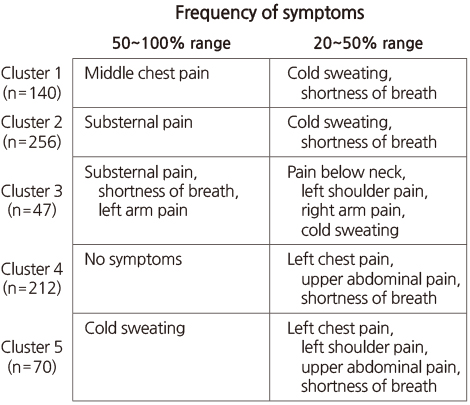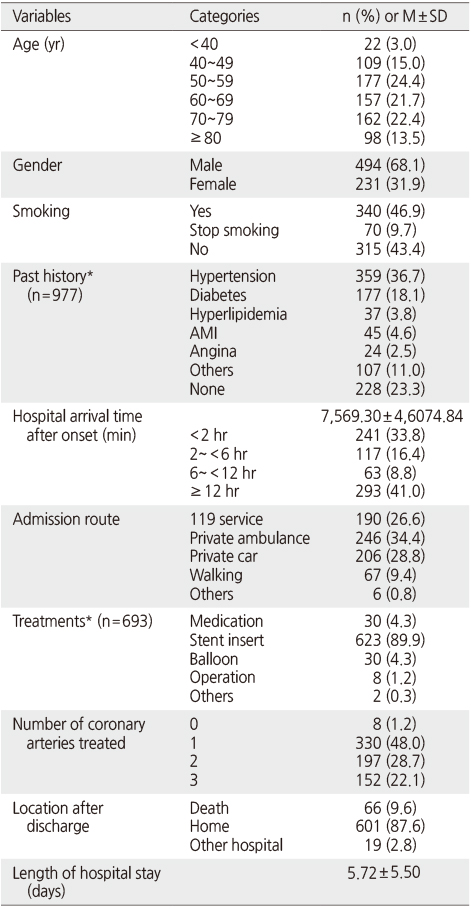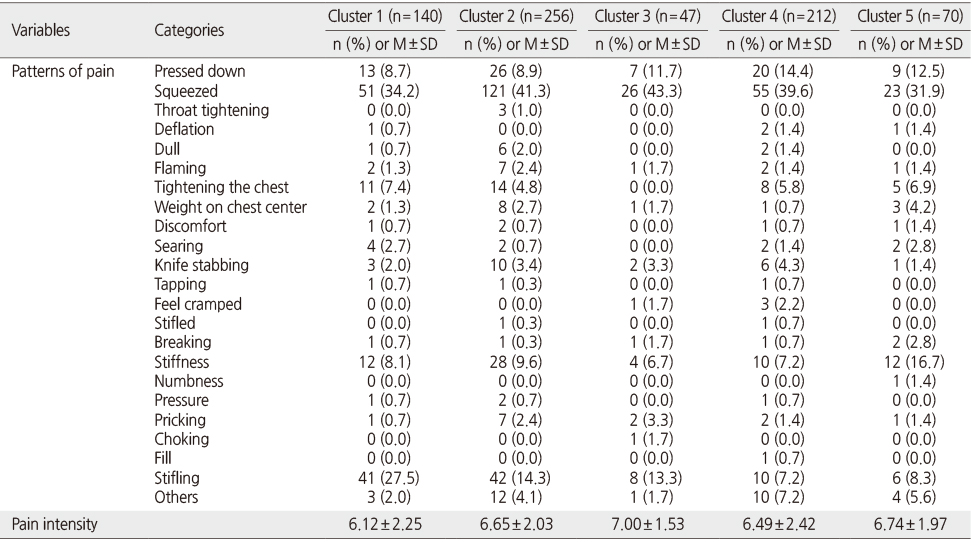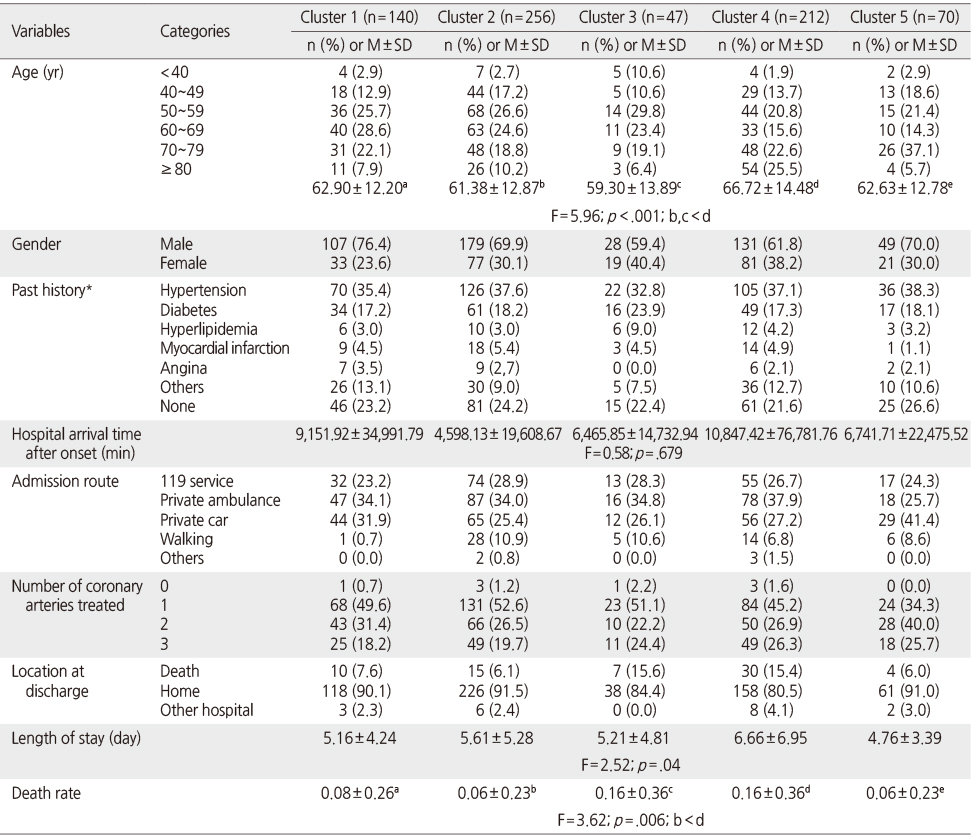Articles
- Page Path
- HOME > J Korean Acad Nurs > Volume 45(3); 2015 > Article
-
Original Article
- Symptom Clusters in Korean Patients with Acute Myocardial Infarction
- Eunjin Park, Jia Lee
-
Journal of Korean Academy of Nursing 2015;45(3):378-387.
DOI: https://doi.org/10.4040/jkan.2015.45.3.378
Published online: June 30, 2015
1Graduate School, Kyung Hee University, Seoul, Korea.
2College of Nursing Science·East-West Nursing Research Institute, Kyung Hee University, Seoul, Korea.
- Address reprint requests to: Lee, Jia. College of Nursing Science, Kyung Hee University, 1 Hoegi-dong, Dongdaemun-gu, Seoul 130-701, Korea. Tel: +82-2-961-0894, Fax: +82-2-961-9398, leejia@khu.ac.kr
© 2015 Korean Society of Nursing Science
This is an Open Access article distributed under the terms of the Creative Commons Attribution NoDerivs License. (http://creativecommons.org/licenses/by-nd/4.0/) If the original work is properly cited and retained without any modification or reproduction, it can be used and re-distributed in any format and medium.
Abstract
-
Purpose
- Acute myocardial infarction (AMI) leads to death if the patient does not receive emergency treatment. Thus it is very important to recognize the symptoms in the early stage. The purpose of this study was to identify clusters of symptoms that represent AMI in Koreans.
-
Methods
- The study used a retrospective, descriptive design with secondary data analysis. Data were abstracted from 725 medical records of AMI patients admitted from June 1, 2006 to August 15, 2014 at a university hospital.
-
Results
- Analysis of the AMI symptoms revealed five symptom clusters; Cluster 1 (n=140): middle chest pain (100%), shortness of breath, and cold sweating, Cluster 2 (n=256): substernal pain (100%), cold sweating, and shortness of breath, Cluster 3 (n=47): substernal pain (95.7%), left arm pain, shortness of breath, cold sweating, left shoulder pain, right arm pain, and the lower neck pain, Cluster 4 (n=212): shortness of breath (28.3%), left chest pain, and upper abdominal pain, and Cluster 5 (n=70): cold sweating (100%), left chest pain, shortness of breath, left shoulder pain, and upper abdominal pain. Length of hospital stay and mortality rate were significantly different according to symptom clusters (F=2.52, p=.040; F=3.62, p=.006, respectively).
-
Conclusion
- Symptom clusters of AMI from this study can be used for AMI patients in order to recognize their symptoms at an early stage. The study findings should be considered when developing educational prevention programs for Koreans with AMI.
The study was partially funded by the New Faculty Research Grant of Kyung Hee University (No. KHU-20061245) and by the National Research Foundation of Korea (No. NRF-2013K2A1A2055139).
This article is a revision of the first author's master's thesis from Kyung Hee University.
- 1. American College of Emergency Physicians. Society for Cardiovascular Angiography and Interventions. O'Gara PT, Kushner FG, Ascheim DD, Casey DE Jr, Chung MK, de Lemos JA, et al. 2013 ACCF/AHA guideline for the management of ST-elevation myocardial infarction: A report of the American college of cardiology foundation/American heart association task force on practice guidelines. J Am Coll Cardiol. 2013;61(4):e78–e140. PubMed
- 2. Rastan AJ, Dege A, Mohr M, Doll N, Falk V, Walther T, et al. Early and late outcomes of 517 consecutive adult patients treated with extracorporeal membrane oxygenation for refractory postcardiotomy cardiogenic shock. J Thorac Cardiovasc Surg. 2010;139(2):302–311. ArticlePubMed
- 3. Health Insurance Review & Assessment Service. Acute myocardial infarction evaluation [Internet]. Seoul, Author. 2013;cited 2014 November 1. Available from: http://www.hira.or.kr/dummy.do?pgmid=HIRAA020041000000&cmsurl=/cms/notice/02/1322009_24959.html&subject=심평원급성심근경색증평가결과치료는세계적수준none
- 4. Statistics Korea. Causes of death statistics in 2012 [Internet]. Daejeon, Author. 2013;cited 2014 May 1. Available from: http://kostat.go.kr/portal/korea/kor_nw/2/6/1/index.board?bmode=read&aSeq=308559
- 5. Van de Werf F, Bax J, Betriu A, Blomstrom-Lundqvist C, Crea F, Falk V, et al. Management of acute myocardial infarction in patients presenting with persistent ST-segment elevation: The task force on the management of ST-segment elevation acute myocardial infarction of the european society of cardiology. Eur Heart J. 2008;29(23):2909–2945. PubMed
- 6. Jacobs AK, Kushner FG, Ettinger SM, Guyton RA, Anderson JL, Ohman EM, et al. ACCF/AHA clinical practice guideline methodology summit report: A report of the American college of cardiology foundation/American heart association task force on practice guidelines. J Am Coll Cardiol. 2013;61(2):213–265. PubMed
- 7. The Korean Society of Emergency Medicine. Emergency medicine. Seoul: Koonja; 2011.
- 8. Chung HJ. The symptoms and the response related to treatmentseeking time among patients with acute myocardial infarction. Nurs Sci. 2008;20(1):33–45.
- 9. Lee JH, Jeong MH, Rhee JA, Choi JS, Park IH, Chai LS, et al. Factors influencing delay in symptom-to-door time in patients with acute ST-segment elevation myocardial infarction. Korean J Med. 2014;87(4):429–438. Article
- 10. Kim HJ, McGuire DB, Tulman L, Barsevick AM. Symptom clusters: Concept analysis and clinical implications for cancer nursing. Cancer Nurs. 2005;28(4):270–284.PubMed
- 11. McSweeney JC, Cleves MA, Zhao W, Lefler LL, Yang S. Cluster analysis of women's prodromal and acute myocardial infarction symptoms by race and other characteristics. J Cardiovasc Nurs. 2010;25(4):311–322. ArticlePubMedPMC
- 12. Ryan CJ, DeVon HA, Horne R, King KB, Milner K, Moser DK, et al. Symptom clusters in acute myocardial infarction: A secondary data analysis. Nurs Res. 2007;56(2):72–81. PubMed
- 13. Choi KC, Choi SS. Factors associated with the prehospital delay in acute myocardial infarction. J Korea Acad Ind Coop Soc. 2013;14(2):707–712. Article
- 14. Han EJ. Impact of symptom recognition and health behavior compliance on hospital arrival time in patients with acute myocardial infarction [master's thesis]. Gwangju, Chonnam National University. 2014.
- 15. Lee SO, Oh SE, Jeong MH, Kim HK, Jeon HJ, Choi YJ, et al. Clinical impact of symptom-to-door time on 1-year mortality in patients with non-ST segment elevation acute myocardial infarction. Korean J Med. 2010;78(6):717–724.
- 16. Lee HN, Cho KJ. Analysis on emergency care to the patients with acute myocardial infarction in pre-hospital and in-hospital phase. Korean J Emerg Med Serv. 2013;17(1):21–39.Article
- 17. Hwang SY, Ahn YG, Jeong MH. Atypical symptom cluster predicts a higher mortality in patients with first-time acute myocardial infarction. Korean Circ J. 2012;42(1):16–22. ArticlePubMedPMC
- 18. Mooi E, Sarstedt M. A concise guide to market research: The process, data, and methods using IBM SPSS statistics. Berlin, DE: Springer; 2011.
- 19. Johnson JA, King KB. Influence of expectations about symptoms on delay in seeking treatment during myocardial infarction. Am J Crit Care. 1995;4(1):29–35.ArticlePubMedPDF
- 20. Kim MJ, Kim KH. Lifestyle differences between middle-aged and old-aged patients with acute myocardial infarction. Health Soc Welf Rev. 2012;32(1):260–280.Article
- 21. Nishiyama S, Watanabe T, Arimoto T, Takahashi H, Shishido T, Miyashita T, et al. Trends in coronary risk factors among patients with acute myocardial infarction over the last decade: The Yamagata AMI registry. J Atheroscler Thromb. 2010;17(9):989–998.ArticlePubMed
- 22. Cho SH, Choi MJ, Jeong MH. Metabolic syndrome risk factors related to severity of coronary artery diseases in patients with acute myocardial infarction. J Korean Clin Nurs Res. 2012;18(1):171–181.
- 23. Ministry of Health & Welfare. Korea Centers for Disease Control & Prevention. Korea health statistics 2012: Korea national health and nutrition examination survey (KNHANES V-3). Seoul: Ministry of Health & Welfare; 2013.
- 24. Woo M, Fan CQ, Chen YL, Husein H, Fang HY, Lin CJ, et al. Gender differences in patients undergoing coronary stenting in current stent era. Chin Med J (Engl). 2011;124(6):862–866.PubMed
- 25. Saczynski JS, Yarzebski J, Lessard D, Spencer FA, Gurwitz JH, Gore JM, et al. Trends in prehospital delay in patients with acute myocardial infarction (from the Worcester heart attack study). Am J Cardiol. 2008;102(12):1589–1594. ArticlePubMedPMC
- 26. Farshidi H, Rahimi S, Abdi A, Salehi S, Madani A. Factors associated with pre-hospital delay in patients with acute myocardial infarction. Iran Red Crescent Med J. 2013;15(4):312–316. ArticlePubMedPMC
- 27. Richards SB, Funk M, Milner KA. Differences between blacks and whites with coronary heart disease in initial symptoms and in delay in seeking care. Am J Crit Care. 2000;9(4):237–244.ArticlePubMedPDF
- 28. Riegel B, Hanlon AL, McKinley S, Moser DK, Meischke H, Doering LV, et al. Differences in mortality in acute coronary syndrome symptom clusters. Am Heart J. 2010;159(3):392–398. ArticlePubMedPMC
- 29. Hwang SY. Comparison of clinical manifestations and treatment-seeking behavior in younger and older patients with first-time acute coronary syndrome. J Korean Acad Nurs. 2009;39(6):888–898. ArticlePubMed
- 30. Arslanian-Engoren C, Patel A, Fang J, Armstrong D, Kline-Rogers E, Duvernoy CS, et al. Symptoms of men and women presenting with acute coronary syndromes. Am J Cardiol. 2006;98(9):1177–1181. ArticlePubMed
- 31. Chin YR, Lee IS, Lee HY. Effects of hypertension, diabetes, and/or cardiovascular disease on health-related quality of life in elderly Korean individuals: A population-based cross-sectional survey. Asian Nurs Res. 2014;8(4):267–273. Article
REFERENCES
Figure & Data
REFERENCES
Citations

- Atypical Symptoms on Admission Predict Progression to Heart Failure in Patients With First-Time Myocardial Infarction
Seon Young Hwang, In Ae Uhm, Sun Hwa Kim, Jiyeong Kim, Myung Ho Jeong
Journal of Cardiovascular Nursing.2025;[Epub] CrossRef - Factors Associated with Mortality of Older Adults Hospitalized via Emergency Departments in Korea
Jungeun Lim, Jia Lee
Korean Journal of Adult Nursing.2020; 32(3): 273. CrossRef - Factors Affecting Care Workers’ Coping Abilities in Emergencies to the Korean Elderly
Soon-Ok Kim, JaeLan Shim
International Journal of Environmental Research and Public Health.2019; 16(16): 2946. CrossRef - Symptom clusters and treatment time delay in Korean patients with ST-elevation myocardial infarction on admission
Hee-Sook Kim, Sang Jun Eun, Jin Yong Hwang, Kun-Sei Lee, Sung-il Cho
Medicine.2018; 97(19): e0689. CrossRef

Figure 1
Sociodemographic Characteristics (N=725)
*Multiple response.
Symptom Clusters in Acute Myocardial Infarction (N=725)
Patterns and Intensity of Pain by Symptom Cluster (N=725)
General Characteristics of Symptom Cluster (N=725)
*Multiple response.
*Multiple response.
*Multiple response.
 KSNS
KSNS
 E-SUBMISSION
E-SUBMISSION





 Cite
Cite

